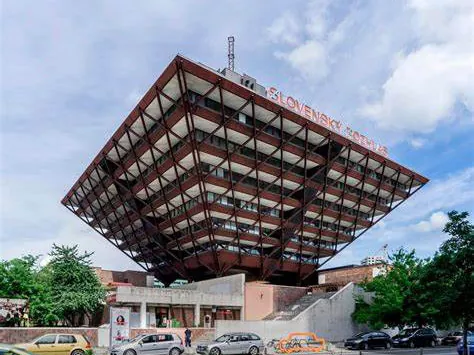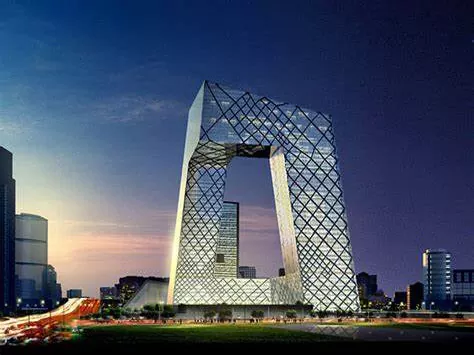QR Code

EIHE Steel Structure’s Steel Structure Broadcasting Buildings are an excellent choice for housing broadcasting facilities due to their strength, durability, design flexibility, faster construction timelines, energy efficiency, and sustainability. With careful planning and execution, these buildings can provide a stable and secure environment for broadcasting operations while also minimizing their environmental impact.
● Strength and Durability: Steel structures are known for their exceptional strength and durability, making them well-suited for buildings that require a robust foundation to support heavy equipment and ensure stability in various weather conditions.
● Flexibility in Design: Steel allows for a wide range of design options, enabling architects and engineers to create unique and visually appealing structures that meet the specific needs of broadcasting facilities. This includes the ability to span large distances without intermediate support columns, which is essential for open-plan studios and control rooms.
● Faster Construction: Steel structures can be prefabricated and assembled on-site, leading to faster construction timelines compared to traditional construction methods. This reduced construction time can help minimize disruption to the surrounding area and allow for quicker occupancy of the building.
● Sustainability: Steel is a recyclable material, and steel structures can contribute to sustainable building practices. Additionally, steel structures can be designed to incorporate energy-efficient features, such as proper insulation and solar panels, to reduce the building's environmental impact.
● Structural Integrity: Given the importance of stability and durability in broadcasting buildings, special attention must be paid to the structural design and engineering of the steel frame. This includes ensuring that the steel members are adequately sized and connected to withstand the loads imposed by the building's use and the local climate conditions.
● Fire Safety: Fire safety is a critical consideration for any building, but it is particularly important in broadcasting facilities due to the potential for high-value equipment and sensitive data. Steel structures are inherently fire-resistant, but additional fire protection measures, such as sprinkler systems and fire-resistant coatings, may be required to meet local regulations.
● Acoustic Control: Broadcasting studios require precise acoustic control to ensure clear and high-quality audio recordings. Steel structures can be designed with appropriate insulation and acoustic treatments to minimize noise transmission and ensure optimal acoustic conditions within the studios.
● Equipment Support: Broadcasting equipment can be heavy and require specialized support structures. The steel frame must be designed to accommodate the weight and size of the equipment, as well as provide easy access for maintenance and upgrades.
In conclusion, Steel Structure Broadcasting Buildings offer numerous advantages over traditional construction methods, including strength, durability, flexibility in design, faster construction timelines, and sustainability. However, careful consideration must be given to structural integrity, fire safety, acoustic control, and equipment support to ensure that the building meets the specific needs of the broadcasting facility.
Steel Structure Broadcasting Buildings are specialized structures designed to meet the unique requirements of broadcasting operations. These buildings house radio and television studios, control rooms, transmission equipment, and other related facilities. Below are the detailed aspects of Steel Structure Broadcasting Buildings:
1. Material Advantages
Steel as the Primary Material:
● Strength and Durability: Steel is renowned for its high strength-to-weight ratio, enabling it to withstand heavy loads and extreme weather conditions. This ensures the structural integrity and longevity of the building.
● Corrosion Resistance: Steel can be treated with anti-corrosion coatings or galvanized to resist rust and corrosion, maintaining the building's appearance and functionality over time.
2. Design Flexibility
● Open Floor Plans: Steel structures allow for large, open spaces without the need for intermediate support columns, making them ideal for broadcasting studios and control rooms that require unobstructed areas.
● Customization: Architects and engineers can customize the design of steel structures to fit the specific needs of the broadcasting facility, including height, layout, and architectural features.
3. Construction Process
● Prefabrication: Steel members such as beams, columns, and braces are prefabricated in a controlled environment, ensuring accuracy and quality. This also speeds up the construction process.
● Erection and Assembly: The prefabricated steel members are transported to the site and assembled using cranes and other heavy equipment. Bolts, welds, or a combination of both are used to connect the members, forming the building's frame.
4. Energy Efficiency and Sustainability
● Insulation: Steel structures can be designed with proper insulation to maintain a comfortable indoor environment while reducing energy consumption for heating and cooling.
● Renewable Energy Integration: Solar panels can be integrated into the building's design to harness renewable energy and further reduce the facility's carbon footprint.
● Recyclability: Steel is a highly recyclable material, and steel structures contribute to sustainable building practices by reducing waste and promoting resource efficiency.
5. Technical Considerations
● Transmission Equipment: The building must accommodate the installation and maintenance of transmission equipment, including antennas, towers, and other related infrastructure.
● Soundproofing: Studios and control rooms require effective soundproofing to ensure high-quality audio recordings and minimize noise interference.
● Electrical and Communication Systems: The building must have robust electrical and communication systems to support the broadcasting operations, including power distribution, data networking, and security systems.
6. Safety and Security
● Fire Safety: Steel is a non-combustible material, providing inherent fire resistance. However, fire safety measures such as sprinkler systems, smoke detectors, and emergency exits must still be in place.
● Structural Integrity: Regular inspections and maintenance are necessary to ensure the structural integrity of the building, including checks on the steel frame, foundations, and other critical components.
● Security: The building must have adequate security measures to protect the broadcasting equipment and personnel, including access control, CCTV surveillance, and alarm systems.
1. How are Steel Structure Broadcasting Buildings designed to meet the unique requirements of broadcasting operations?
Answer:
● Structural Integrity: The design ensures that the building can support the heavy loads of broadcasting equipment and maintain structural integrity under extreme conditions.
● Acoustic Control: Special attention is paid to soundproofing to ensure high-quality audio recordings and minimize noise interference in studios and control rooms.
● Transmission Infrastructure: The building is designed to accommodate the installation and maintenance of transmission equipment, including antennas, towers, and other related infrastructure.
2.What are the safety considerations in Steel Structure Broadcasting Buildings?
Answer:
● Fire Safety: Steel is inherently fire-resistant, but fire safety measures such as sprinkler systems, smoke detectors, and emergency exits are still necessary.
● Structural Monitoring: Regular inspections and maintenance are conducted to ensure the structural integrity of the building, including checks on the steel frame, foundations, and other critical components.
● Security: Access control, CCTV surveillance, and alarm systems are implemented to protect the broadcasting equipment and personnel.
3. Are there any limitations to using Steel Structure Broadcasting Buildings?
Answer:While Steel Structure Broadcasting Buildings offer many advantages, there may be some limitations depending on specific requirements and site conditions. For example, the cost of steel may be higher than other building materials in some cases, and the construction process may require specialized equipment and skilled labor. Additionally, the design and construction of steel structures must comply with local regulations and standards, which may impose certain constraints. However, with careful planning and execution, these limitations can be overcome to create successful Steel Structure Broadcasting Buildings.
4.Can Steel Structure Broadcasting Buildings be customized to meet specific requirements?
Answer:Yes, Steel Structure Broadcasting Buildings can be customized to meet specific requirements such as size, layout, architectural features, and technical specifications related to broadcasting operations. Architects and engineers work closely with clients to design a building that meets their unique needs.
5. What are the main advantages of Steel Structure Broadcasting Buildings?
Answer:
● Strength and Durability: Steel structures are known for their high strength-to-weight ratio, making them capable of withstanding heavy loads and extreme weather conditions.
● Design Flexibility: Steel allows for open floor plans and customization, which is essential for broadcasting studios that require large, unobstructed spaces.
● Speed of Construction: Steel structures can be prefabricated and assembled quickly, reducing construction time and minimizing disruption to ongoing broadcasting operations.
● Energy Efficiency: Steel structures can be designed with proper insulation and integrated with renewable energy systems to reduce energy consumption and contribute to sustainability.


Address
No. 568, Yanqing First Class Road, Jimo High-tech Zone, Qingdao City, Shandong Province, China
Tel

Copyright © 2024 Qingdao Eihe Steel Structure Group Co., Ltd. All Rights Reserved.
Links | Sitemap | RSS | XML | Privacy Policy |
TradeManager
Skype
VKontakte
